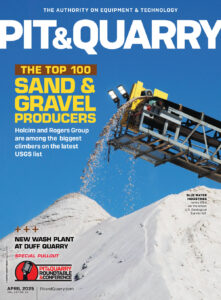
The bulk of my time in the pit and quarry business has been spent in New England, where customer demand is seasonal in nature.
From a safety professional perspective, seasonal businesses face a unique challenge – a year’s worth of work is often done in a span of six to seven months. Because of this dynamic, organizations contend with turnover, time pressure, high temperatures at the height of the season and heightened fatigue.
These factors can contribute to conditions that increase the risk of human error and unsafe behavior.
Fatigue: What is it?
We all know what fatigue feels like. Your body has either been up too long or worked too hard – or a combination of both.
Fatigue worsens when this pattern continues over time. If not controlled, it can impact one’s physical, cognitive and emotional abilities.
According to the Centers for Disease Control & Prevention, fatigue also manifests through slow reaction times, reduced attention and concentration, and impaired judgment.
I have seen the effects of fatigue manifest in various incidents. Early in my time in pits and quarries, I investigated a simple event where a person fell backward – from ground level – onto a square, metal fuel container. The fall resulted in fractured ribs.
At first glance, the event was relatively innocuous – one of the slip/trip/fall variety. But people don’t fall backward easily – especially from ground level – so I dug deeper into the analysis.
As I investigated how many hours the individual had worked that week, it was clear he had logged more than 100 hours. Throw stress, heat, staffing concerns and other curveballs into the mix, and you have a recipe for an incident.
Managing fatigue
Following the event, the members of the executive management team looked at themselves and came up with a better process to monitor employee hours across sites.
A color-coded report showing hours worked was distributed each week:
• Yellow for employees working more than 50 hours
• Orange for those over 60 hours
• Red for those over 70 hours
The visual helped the team identify trends early and intervene. “One-off” weeks where long hours were worked still occurred. But trends were noticed quicker, and significant events from fatigue were reduced dramatically.
Managers have an obligation to their teams to act as outlined above. Still, on-the-ground employees also have responsibilities. Here are a few things all employees should keep in mind:
• Know your limits. Fatigue is a personal condition. If you’re burning the candle at both ends by overdoing it at home as well, it’s possible to be fatigued at work even if you’re only working 40 hours a week.
• Rest. In the heat of the summer and at the peak of the season, employees must prioritize rest when they can. Getting a full night’s sleep is very helpful to decision-making – and your personal safety.
• Breaks. Motors can run until they break down, but people can’t. Good supervisors will make sure they don’t allow their team members to burn out.
• Planning. When an operations team is planning activities like maintenance or construction, they should be very cognizant of fatigue issues. Proactively planning would mean considering the hours it will take to accomplish activities and then seeing how that impacts people in the field. This is where management should consider staffing levels and workload.
• Hydrate. As covered in this space last month, dehydration and heat stress can greatly impact fatigue.
• Stress. Everyone has some level of stress, but chronic or serious stress is very tiring and directly correlates with fatigue level.
Other fatigue concerns
Fatigue can pop up in any aspect of a company.
Long days outside will likely present fatigue issues for those working in the field, but be aware that other departments in an organization can contend with the same challenges during the season. This includes mechanics, dispatchers, administrators, management and others, as no one is immune from fatigue issues.
To all those supervisors and team leaders reading this: Watch your teams, monitor their hours worked and plan out activities to minimize fatigue’s effects – particularly at the height of the season.
Stay safe out there, and please email any photos you’d like to see spotlighted here.
Previous column: How to keep yourself safe in the heat
Steve Fuller has worked over the past 20-plus years with a variety of industries – including aggregates – in operational and safety leadership roles. Now representing Steve Fuller Company, he can be reached at steve@stevefullercompany.com.












